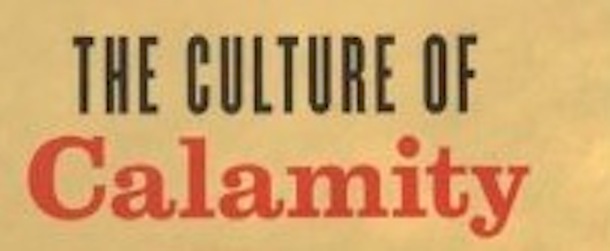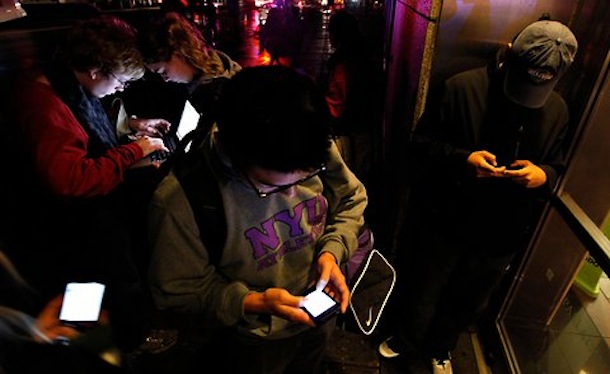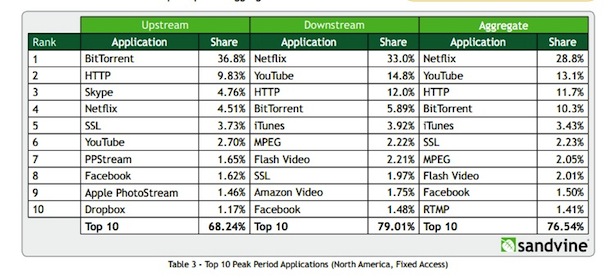An iconographic and text archive related to communication, technology and art.
In this new roundup of links featured on Aphelis’s Twitter account over the past few weeks, a discussion about the different merits of art-house films vs. mainstream movies, two books on the idea of community based on Jean-Luc Nancy’s philosophy, a new upcoming documentary featuring Slavoj Zizek, another documentary this time about Austrian filmmaker Michael Haneke (who won this year Palme d’Or at Cannes), a book exploring the “culture of calamity”, some thoughts about the function of Twitter during hurricane Sandy shared by The New York Times columnist David Carr, a new four-part HBO documentary series about photojournalism, the weight of Netflix on downstream traffic and, finally, a brief introduction to “yellowism” a.k.a. what happened to the Rothko painting which got tagged recently.
• • •
-
The New Yorker: “Movie Culture, Or, Fun In The Dark” by Richard Brody, October 10, 2012. Brody offers a good argument about the so-called distinction between “popular” culture and “high” culture.
In general, it’s a grotesque parody to suggest that viewers who enjoy movies that aren’t mainstream Hollywood productions do so in some second-order, snobbish, or unemotional way. It’s as silly as claiming that classical music and opera are less emotional than pop music, and it’s a claim that, like O’Hehir’s comment about cocktail-party chatter, is mainly a sign of not getting out enough, of not knowing people who can tell him otherwise.
-
The New Yorker: “Le blog de Jean-Paul Sartre” by Bill Barol, October 16, 2012.
This morning over breakfast S. asked me why I looked so glum.
“Because,” I said, “everything that exists is born for no reason, carries on living through weakness, and dies by accident.”
“Jesus,” S. said. “Aren’t you ever off the clock?”
-
New Books in Critical Theory: a review of J. Hillis Miller’s The Conflagration of Community: Fiction Before and After Auschwitz (University of Chicago Press) by Brandon J. Fiedor, August 23, 2012.
In his recent book, The Conflagration of Community: Fiction Before and After Auschwitz (University of Chicago Press, 2011) , J. Hillis Miller sets outs to address Theodor Adorno’s famous proclamation that to write poetry after Auschwitz is impossible and barbaric. One should make clear from the outset that Miller’s central project in this regard is not to make some grand claim about the value or worth of literature in the face of dehumanization and atrocity. The value of literature for him and for us is a given. There is nothing to argue. Rather, Miller is most concerned with addressing the question of whether or not literature can truly bear witness to the Shoah. While this question has indeed been a central concern of literary scholars, philosophers, and artists since Celan and Adorno, Miller’s method of approaching this topic by way of the theoretical concept of “community,” and more specifically, “literary communities,” is rather intriguing. Here, Miller invokes the work of Derrida and Jean-Luc Nancy in particular.
-
In a letter he wrote to Walter Benjamin, Theodor Adorno offers us a remedy to the temptation of claiming “firsts” (“for the first time”, “this is the first case”, etc.):
in general, the use of “first” tends to give me pause”
The letter appears in the third volume of Walter Benjamin’s Selected Writings: 1935-1938, Harvard University Press, 2003, p. 58.
-
The Pervert’s Guide To Ideology by Sophie Fiennes, 2012:
The makers of The Pervert’s Guide To Cinema return with The Pervert’s Guide To Ideology. Philosopher Slavoj Zizek and filmmaker Sophie Fiennes use their interpretation of moving pictures to present a compelling cinematic journey into the heart of ideology – the dreams that shape our collective beliefs and practices. (read more)
-
Cinephilia & Beyond: “24 Realities per Second: A Documentary on Michael Haneke” reviewed by Oksana Dykyj, Oct. 27, 2012.
Nina Kusturica, apparently a distant relative of the well-known film director Emir Kusturica, and her long-time collaborator on camera and direction, Eva Testor founded their own production company with their first project revolving around a film director Michael Haneke. Since Haneke had taught at the Vienna Film Academy where both women had been students, the familiarity between subject and filmmakers is apparent as when he plays to the camera, at one point good-humoredly thrusting a script right up to the camera/audience. Jean-Luc Godard’s now-famous dictum “The cinema is truth 24 frames per second” is borrowed for the documentary’s title, and yet right at the start of the film, Haneke adapts both Kustirica and Testor’s title as well as Godard’s dictum by saying, “I always say that film is 24 lies per second at the service of the truth or at the service of the attempt to find the truth.”
-
University of Chicago Press: The Culture of Calamity. Disaster and the Making of Modern America by Kevin Rozario, 2007.
If the content of movies, video games, and network news reports is any indication, we live in a culture of calamity. It sometimes seems that we can’t turn on our televisions without encountering dramatic images of destruction: a hurricane battering a southern resort; a sea of fire engulfing a national forest; a great river breaking through its levees and rolling over the surrounding countryside; a tower of glass and steel bursting into flames and crumbling to the city streets below. Why are these images ubiquitous? What makes disasters so fascinating, so thrilling, so involving?
-
n + 1: “The End, The End, The End. Why bother dreaming up a devastated world when you live in one?” by Chad Arbach, Fall 2007. First spotted via Anagnori.
The problem with the post-catastrophic novel, in the end, is that it enforces a false distinction between what is and what will be; between what we’re doing and what we might someday do. Why bother dreaming up a devastated world when you live in one? A possible posterity has always hedged the novelist’s hopes; he consoles himself for his lack of money and political power by imagining his future readers. But that future readership depends on an elaborate system of production and distribution that subsequent generations may not enjoy. The only time the novel can count on is now, and the catastrophes that need describing are neither exotic nor hypothetical.
-
The New York Times: “How Hurricane Sandy Slapped the Sarcasm Out of Twitter” by David Carr, October 31, 2012.
And then along came Hurricane Sandy. For most of Monday, people on Twitter were watching an endless loop of hurricane coverage on television and having some fun with it, which is the same thing that happens when the Grammys or the Super Bowl is on. But as the storm bore down, Twitter got busy and very, very serious.
-
Writers No One Reads: “Question your teaspoons: an interview with Oulipian Daniel Levin Becker” by Stephen Sparks, November 4, 2012.
One of the more charming characteristics of Many Subtle Channels are the footnotes scattered throughout the text. You mentioned that your publisher… suggested… that you cut several. Are there any excised notes you particularly care to share with the world?
Ooh, what an offer. (I have a project in the queue—where it’s probably of more use to everyone than in any sort of incarnation—called “Index of murdered darlings,” consisting entirely of things I was compelled, by my editor or by better judgment, to excise from MSC.) I was actually trying the other day to find an early footnote about the supposed “pirate translations” of the essay in which Calvino breaks down the algorithm he used for If on a winter’s night a traveler, and could find no trace of it anywhere.
-
HBO: Witness a four part documentary series on photojournalism produced by Michael Mann and David Frankham. A review from The New York Times: “Photographers Amid Chaos” by Mike Hale, November 4, 2012.
“Witness: Juarez,” the first in a series of four HBO documentaries about contemporary war photographers, is the visual equivalent of a fast-paced duet, like Mozart for still camera and video camera rather than violin and viola. The photographer Eros Hoagland and the cinematographer Jared Moossy travel the deadly streets of Ciudad Juárez, Mexico, in tandem, and our view jumps between their lenses; their photographs and moving images echo and amplify one another.
-
Continuum (a Bloomsbury company): Jean-Luc Nancy and the Question of Community by Ignaas Devisch, 2013.
The question of community is central to our daily life: where do we belong to, what do we share with each other? The French philosopher Jean-Luc Nancy has made these questions one of the central topics of his oeuvre. Jean-Luc Nancy and the Question of Community is the first to elaborate exhaustively this question within Nancy. Ignaas Devisch sketches the philosophical debate on community today and puts the work of Nancy within its intellectual context, from Heidegger and Derrida, to Bataille and Blanchot.
-
GigaOM: “Based on network traffic alone, Netflix handily beats Amazon, HBO & Hulu” by Janko Roettgers, November 7, 2012.
Netflix accounts for 33 percent of all of North America’s peak residential downstream traffic, which makes it much bigger than any of its direct competitors: Based on those traffic numbers alone, Netflix sees more than 60 times as much usage as HBO Go.
-
Animal New York: “Interview With the Yellowist: Why Rothko Got Tagged and You’re Next” by Marina Galperina, October 10, 2012.
“Like Duchamp who took objects from reality and turned them into art, we can go a step farther and take objects from art and put them into the third context. They are not works of art anymore. They become pieces of Yellowism. Art already exists. Yellowism is a new context.”
- By Philippe Theophanidis
- on
- ― Published in Link-roundup




